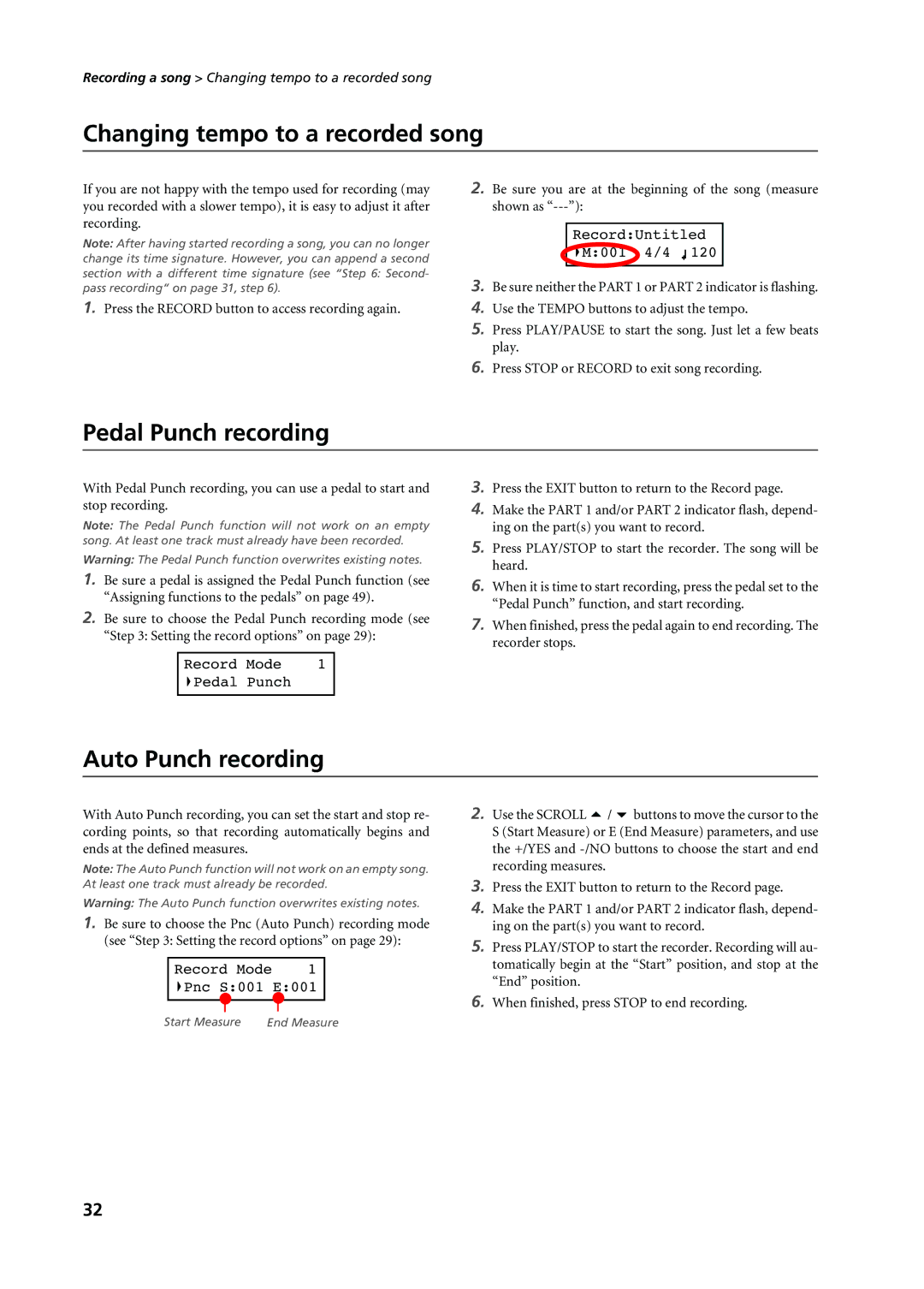User’s Manual
Page
Important Safety Instructions
Data Reset
Contents
Main features
Introduction
Two sets of headphones
Adjustable pitch
Powerful integrated amplification
Temperaments
Control panel
Performance button
Chorus
Connections
Connecting other audio devices to the C-720
Connecting to external audio devices
Connecting to an external amplification system
Amplification, connect only the L/MONO output. Do not con
Open the key cover
Using the music stand
Before you begin
Turning the instrument on
Listening to the Demo
Adjusting the volume
Using the headphones
Listen to a specified song
Before you begin Listening to the Demo
Basic functions
Playing a single sound Single mode
When you turn the instrument on, it is in Single mode
GrandPiano 4/4
Playing two sounds at the same time Layer mode
Selecting a different Left sound
Entering the Split mode
Exit from the Split mode
Choosing a different split point
Using the pedals
Transposing
Press the Transpose button to show the Transpose dis- play
Changing the brilliance
Turning the effects on/off
Transpose +02 semitones
Perf.01 4/4 Split&Layr
Using performances
Choosing performances
Performance Button Bank
Editing a performance
Changing the sounds assigned to a performance
Piano&Str Ac. Bass
Metronome
Starting and stopping the metronome, adjusting the tempo
Adjusting the tempo
Tempo and time signature display
Press the Exit button to return to the Main
Choosing a time signature
Drum patterns
Metro TS/Tempo
Saving the metronome settings
Adjusting the metronome level
Adjusting the drum pattern’s reverb
Selecting the accent
Playing back a song
Accessing the Song Play mode
How to select a song
After you press the Song button, the Song Play page appears
AlbumSongBook 01-Prelude Prelude 1 M--- 4/4
How to start playback
Starting from a different measure
After having selected a song, you can play it back
Changing the song’s tempo
Muting/unmuting a recorder’s part
Play along with the song
Cycle Play
Turning the Cycle Play off
Entering Record mode with a new, blank song
Quick recording procedure
Entering the Record mode
Entering Record mode with an existing user song
Selecting sounds
Setting the record options
Recording with no metronome
Setting the time signature and tempo
Recording
Recording with the metronome
RecordUntitled M099 4/4
Second-pass recording
Changing sounds to a recorded song
RecordUntitled M--- 4/4
Changing tempo to a recorded song
Record Mode Pedal Punch
Record Mode Pnc S001 E001
Pedal Punch recording
By choosing to record a new song
By choosing the Save Song command
Saving the song
By choosing a different song
Erasing a track
Setting Cycle Play
Editing a song
Play mode, whose use has been seen above see Cycle Play on
Cut Measures From 99 Exec?
Cutting measures at the end of the song
Quantizing the song
Quantize Q1/16 Exec?
Saving the song after editing
Transposing the song
Deleting the song
Choose a transposition value in semitones
Editing a song Saving the song after editing
Editing sounds and performances
Accessing the Sound edit mode
Exit from the Sound edit mode
Saving a sound
After editing a sound
Press +/YES to confirm, -/NO to cancel
Saving a performance
Press the +/YES button to go to the Save To Performance
Use this page to set each sound’s volume
Setting the volume
Adjusting the panning
After editing a performance
C-720 is equipped with three types of effects
Adjusting the effects
Setting the reverb effect
Press Scroll again to select the Reverb On/Off pa- rameter
If you are in Layer or Split mode, press Scroll
Setting the chorus or modulation effect
Setting the insert effects
Use the +/YES and -/NO buttons to select a different effect
Octave +02 L+00
Setting the octave transposition
IFX Wet/Dry MW099 LD020
To select the L Layer/Left parameter
Adjusting the fine tune
Programming the pedals
With the M Main parameter selected
Selecting a scale
SubScale Type Kirnberger
SubScale Sw MOn LOff
Resetting the current sound and performance
Reset Snd/Prf Exec?
Accessing Global edit
Global settings
Touch settings
Exit from the Global edit mode
Default split point
Master tuning
Brilliance
Assigning functions to the pedals
Pedal 3 Glob Sound Pedal 2 Glob Sound Pedal 1 Glob Sound
Mute Level
Quarter Tone SubScale realtime programming
Fast Play
Use the +/YES and -/NO button to choose the mute level
Midi Clock
Turning the keyboard on or off Local Control
Midi in Channels
Midi in Ch Ch01 Tr01
Midi OUT Channels
Press the Scroll Button to move the cursor to Channel again
Button to show the Midi OUT Channels
Data transfer via the USB port
Midi Filters
Tus of the selected filter
On a Mac Drag the Korg SSD icon over the Eject icon
Folder Content
Erasing songs from the User Song album
Erase Song Prelude Exec?
System version number
General Reset
General Reset Exec? Yes/No
You can see the operating system’s version number while
What can you do with MIDI?
What is MIDI?
What is Midi Over USB?
Midi connections
Using the C-720 as a multitimbral tone generator
Standard Midi settings
Program Change
Control Change enable/disable
Control Change
Korg USB-MIDI Driver system requirements
Installing the Korg USB Midi Driver
Connecting the C-720 to a personal computer
Please note before use
Mac OS X Installing Korg USB-MIDI Driver
Windows Installing the Korg USB-MIDI Driver
Driver’s ports
Assembling the stand
Fasten the two pieces using two screws a
Assembling procedure
For assembly
By inserting the four bolts on the front of the pedal
Assembling the stand Assembling procedure
Assembling the stand Assembling procedure
Remove
Left Speaker Right Speaker Pedals
Disassembly
Check after assembly
Screw loosening
Sounds
Appendix
Var Name CC32 Osc Description
Var. Name CC 0 CC32 PC* Osc. Description
Drum Kits Selected only by Drum Patterns or via Midi
Btn Name Sounds / Timbres Mode Remarks Bank
Performances
Effects
Reverb Description / Beschreibung Chorus
Album SongBook Title Composer
Songs
Album Classics Title Composer
Page
Error messages
Problem Possible remedy
Troubleshooting
Polyphony
Technical specifications
Specifications 720
Midi Implementation Chart
RPN LSB, MSB
Page
Page
Korg Italy 2006. All rights reserved

